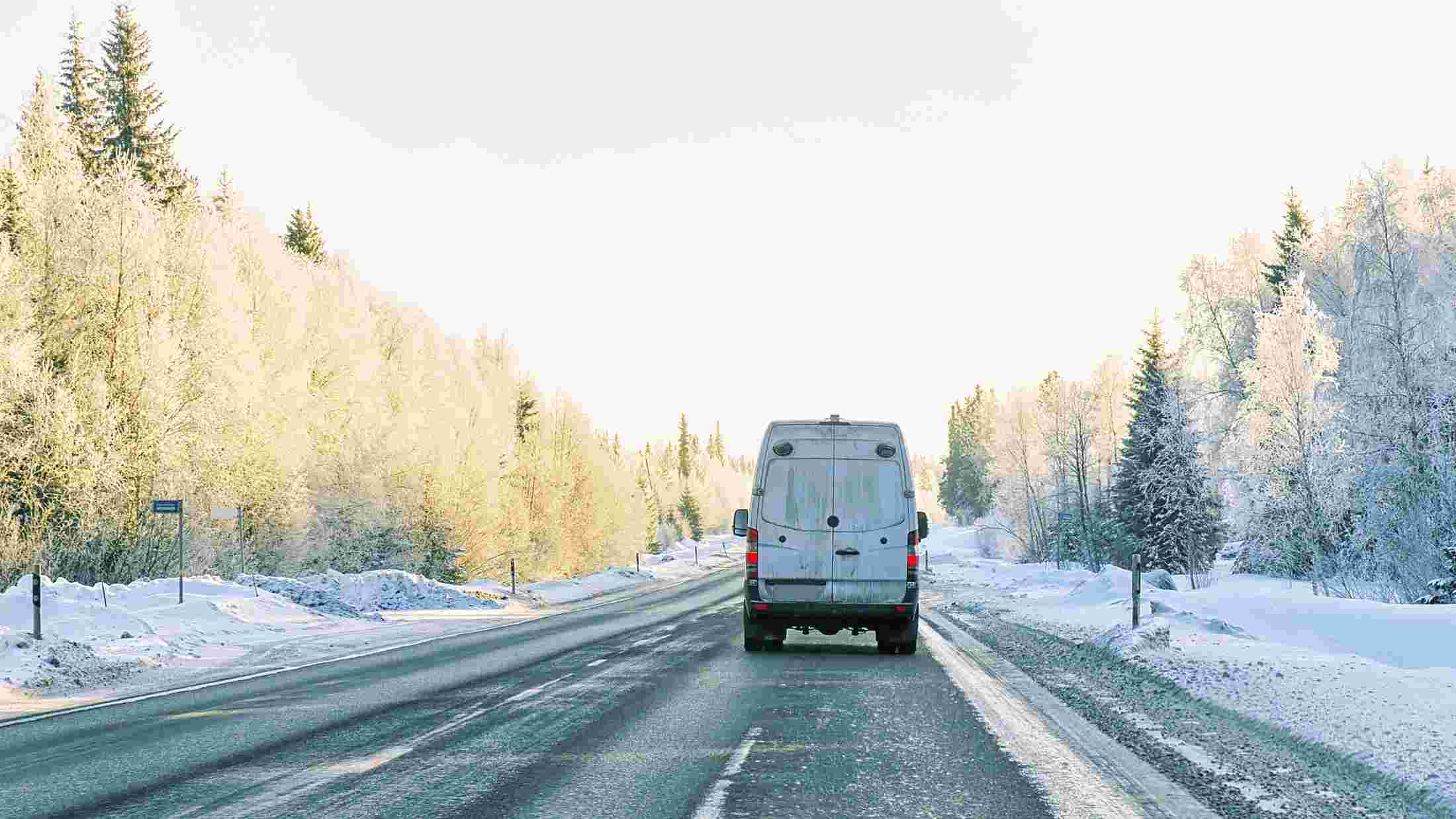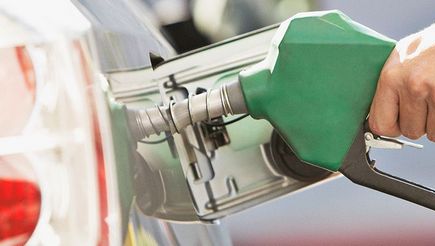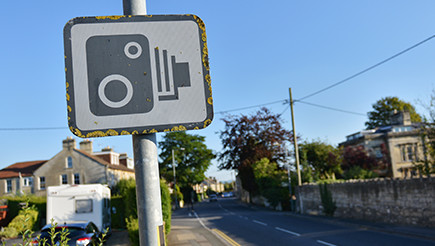The UK’s unpredictable climate means drivers need to be prepared for all weathers. Even the most experienced motorists can fall short when they’re faced with adverse weather conditions. Whether it’s reduced visibility or slippery surfaces, it can be difficult to react to road hazards when the weather’s bad.
Here, AXA summarises the information on the Highway Code to make sure you’re safe when driving your van in:
General advice for bad-weather driving
The Highway Code advises against driving in bad weather conditions. However, when you drive a van for work or as part of your business, that’s not always possible. Not to mention that the weather can quickly turn when you’re already out and about, leaving you vulnerable to driving in extreme conditions.
Preparation is key and keeping a well-maintained van is more important than ever when the weather’s bad. That’s why you should service your van regularly and always check your tyres before you set off. If you need to make an essential journey or you get caught short, just remember the four Ss….
- Slow down
- Safe distance
- Switch on/off lights
- Stay alert
Top tip: If you know the weather is going to lead to difficult driving conditions, make sure your phone is fully charged in case of emergencies; just don’t be tempted to use it when you’re driving.
How to drive a van in…
Heavy rain and floods
The UK’s wet climate means that heavy rain and flooding are common. From low visibility to reduced traction and braking power, heavy rainfall poses various challenges for drivers, especially if you’re in a larger vehicle like a van.
At high speeds, drivers can lose control and ‘aquaplane’ across the road. This happens when tyres skim across surface water instead of the road itself; a frightening experience for any driver. That’s why it’s important to drive slowly and leave a bigger gap than normal between you and the vehicle in front.
Here are a few things other things to keep in mind when you’re driving during a downpour or in an area that’s flooded:
- Ease off the accelerator and slow down gradually if your steering becomes unresponsive
- Only drive over an area of road if you can see the road itself through the water
- If you need to drive over a flooded area, stay in the middle of the road in first gear
- Test the brakes as soon as you drive through a large body of water or a flooded area
Top tip: Windscreen wipers should be replaced every 6-12 months. You'll know it's time to change them when they start to smear water on your windscreen.
Snow and ice
While snowfall doesn’t usually stick on the roads in the UK, when it does it can pose a danger to drivers who are unprepared for thick snow or black ice.
When there’s an expected cold snap or snow expected, the first thing you’ll need to consider is whether it’s even safe to drive in the first place. If your journey is essential, you’ll need to take great care and allow more time than usual. Here are some simple tips to help you keep safe in your van during the colder wintry months.
What to pack:
- Add anti-freeze in your radiator and windscreen washer.
- Check you’ve got de-icer and a scraper in your van.
- Pack a winter emergency driving kit: torch, blanket, food and drink, first-aid kit, warning triangle and high-visibility vest.
How to drive:
- Make sure your windscreen is completely clear. Don’t be tempted to just clear a little area so you can drive off sooner.
- Drive at a slow speed in as high a gear as possible – accelerate and brake very gently.
- Brake on the straight before you reach a bend. Then, steer smoothly round the bend and avoid sudden actions.
Watch out: Clear the snow off your van’s roof before you set off. Not only could it cause an accident, but you could also be landed with a fine and penalty points.
Fog
Fog poses a threat to drivers because it can seriously reduce visibility and blur perception. Some drivers even think stationary objects are moving, which explains why accidents in fog are so common.
However, there are simple things you can do to make sure you can see and be seen when driving you van in the fog. Before you set off, you might want to consider an alternative route where it’s less foggy. Fog typically collects near water first, but you’ll be able to check on a modern satnav or phone GPS.
Here are some other tips to help you stay safe in your van:
- Drive slower than normal so you’ve got more time to react if traffic stops or a hazard appears
- Turn the radio off and roll down your window so you can hear the traffic
- Avoid any unnecessary braking and indicate well in advance if you’re changing direction; the driver behind you will probably be using your lights as a guide
- Use your low-beam headlights and avoid using your high-beam
- Switch off your fog lights as soon as visibility improves to avoid dazzling other road users
Driving hack: If you can’t see the next streetlight from the one you’re passing, you probably need to turn on your fog lights.
High winds
If you're new to driving a van, it's safer to avoid travelling in high winds until you feel totally comfortable with steering and handling. Medium and large-sized vans are prone to being pushed sideways when strong gusts hit them, which means it's important to react and steer quite quickly to compensate. Even though many newer models come with technology to help stabilise vans during high winds, you’ll still need to be vigilant. The weather can be so unpredictable that you need to adapt quickly and stay alert at all times.
Even if you drive a smaller van, you’ll still need to alter the way you drive to give other road users more space; especially cyclists and large vehicles as they’re easily buffeted by side winds. Here are some easy tips to follow when you’re driving in high winds:
- Take extra care when you’re passing over bridges or open stretches of road where you’re exposed to strong winds
- Be mindful of your speed as it’s harder to control a vehicle travelling at speed during a crosswind
- Keep both hands on the wheel in case the wind begins to move your van. Go back to basics with the 10 to 2 or quarter to 3 position
Try this: Plan your journey to avoid country roads. They’re far more likely to be blocked by fallen trees or debris.
A heatwave
Hot sunshine can cause dehydration and exhaustion; a dangerous combination if you’re driving. The Department for Transport published research suggesting there are more vulnerable road users during warmer temperatures which could lead to more accidents. If your van isn’t fitted with air conditioning or you don’t drink enough water, the effects of a heatwave can quickly take a turn for the worst.
However, there’s more to driving in a heatwave than just turning on the air-conditioning, here are some things you can do to make sure you keep your cool when you’re driving during a heatwave.
- Check your tyre pressure. Excessive heat can cause the air inside tyres to expand and the tyre pressure to rise which can lead to tyre blowout.
- Make sure you’ve got plenty of water in your van to avoid dehydration. Some drivers like to keep a mini fridge to keep things cool during longer journeys.
- Pull over as soon as your engine starts to overheat (you’ll probably start to smell something burning). Continuing to drive even for a short distance could cause serious damage and cost you a lot more money in the long run.
- Keep your van parked in the shade and consider using coverings for the windows.
Be careful: While it may be tempting to wear flip flops or strappy sandals to keep you cool, they can be counterproductive to safe driving and potentially increase the chances of an accident.
Winter sun
As well as the more obvious hazards van drivers face during the colder months, the dazzle from bright sun can be extremely dangerous.
During the spring and winter, the low angle of the sun can often mean your visor doesn't actually shield your eyes from the glare. Thankfully, there are a few simple things you can do to improve your visibility and generally make sure you’re safer when you’re driving in bright sun.
- Keep a pair of sunglasses in your van all-year round and wear them in bright sunshine; especially if it’s low or reflecting off a wet road.
- Make sure your windscreen is clear before you set off. And whenever you need to, pull over and wipe clean if you think it’ll improve your visibility.
- Be more of aware and patient of other vehicles on the road - they’ll also affected by the sun’s glare.
- If you’re struggling to see anything at all, you should pull over to a safe place and wait until the sun moves a little.
Did you know? Polarised sunglasses are the best at combating glare. Find a retailer that carries the CE mark which means they’ve been tested to European safety standards.
Bad weather and van insurance
When it comes to driving in bad weather, the best advice is that if the weather looks like it’s causing difficult driving conditions, don’t drive. But sometimes that’s just not possible, especially if your business depends on your van being out on the road.
So if you must drive in bad weather conditions, it’s important to understand how this might affect your van insurance policy.
Many insurance policies will contain a condition which says that the driver has a duty to take care of their vehicle at all times. Aside from keeping it roadworthy, this also means taking reasonable and necessary precautions to drive safely and avoid damage where possible.
This means that you should take reasonable effort to protect your van from damage while driving in bad weather. So if you were to knowingly drive into floodwater, for example, and your vehicle sustains damage, you may not be able to make a claim if this could have been avoided.
These types of exclusions can exist for breakdown services too – if your vehicle becomes buried in snow, mud or is partially or fully underwater, you may not be able to claim for breakdown help or recovery in some cases.
If you’re unsure, speak to your insurer or check your policy wording before making any journeys in bad weather conditions.



